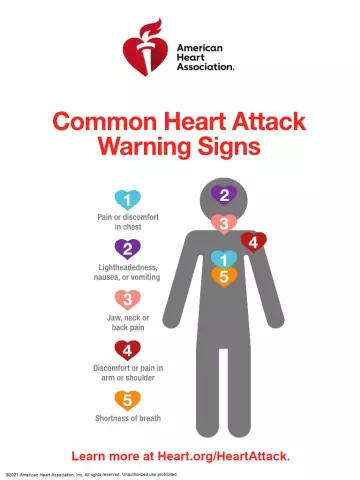- Author Rachel Wainwright [email protected].
- Public 2023-12-15 07:39.
- Last modified 2025-11-02 20:14.
Disability after myocardial infarction and stenting
The content of the article:
- Temporary disability after myocardial infarction
- Certification - what is it?
- Disability groups after a heart attack
- Getting a disability after stenting: what is needed for this
- Who should not work after suffering myocardial infarction
- Prevention and rehabilitation
- Video
Disability after myocardial infarction, a serious disease of the cardiovascular system, in which necrosis of the heart muscle develops against the background of circulatory failure, has features of establishment. After a heart attack, treatment and rehabilitation, the full recovery of cardiac function does not occur, but the body adapts to new conditions.
Most often, myocardial infarction is recorded in men at the age of 40-60 and women after 50, ie, of quite working age. Some of the patients subsequently return to their previous activities, in some cases limited working capacity remains, and some lose it completely.

In some cases, after a heart attack, the patient is advised to change profession or retire due to disability
A postponed heart attack, even in the most successful cases, requires a long-term rehabilitation and lifestyle changes from the patient, since the risk of complications and a second heart attack is high. Therefore, some patients are shown to change the type of activity, first of all, in the presence of occupational hazards that can aggravate the patient's condition.
Temporary disability after myocardial infarction
After myocardial infarction, the patient is assigned the status of a formal disabled person - temporary disability. This means that for several months (the exact period and conditions must be clarified with the attending physician, since these parameters are determined in accordance with the current legislation in each specific case), the patient is given time for rehabilitation, during which sick leave payments are due. After this period, you should go through the certification procedure, during which the need to assign a disability group is determined.
Certification - what is it?
Whether or not they give disability in myocardial infarction depends on the severity of the disease, the presence of complications, the general condition of the patient and a number of other conditions. Certification is carried out by a special commission, whose activities are regulated by the state.
Each case is considered by the commission in accordance with the existing criteria. The patient's ability to act, his ability to self-service, the level of adaptation of the body to new conditions of existence are assessed, the patient's education, his profession and qualifications - everything that affects the ability to work - is also important. Working capacity is understood as a state of health that allows you to perform work of a certain volume and quality. After that, the commission decides whether to give a disability group to a specific patient and which one.
For certification, a passport (or other identity document of the patient), documents on the education and work of the patient, pension certificate, insurance number of the individual personal account, medical documents, application, referral for examination are required. The exact list of documents must be checked with a specific institution.
Disability groups after a heart attack
With insignificant, but permanent and reducing the ability to work, postinfarction disorders on the part of the cardiovascular patient are assigned group 3 disability. If, before a heart attack, such a person performed work that did not require physical effort, for example, was engaged in intellectual work, he can return to previous work activities.
With a less favorable prognosis, especially with regular exacerbations of angina pectoris, it is possible to issue group 2 disability, which provides for a partial limitation of working capacity. Such a patient can engage in activities that do not require significant efforts (physical and psychoemotional), but at the same time he needs to undergo regular rehabilitation treatment.

If the patient periodically requires treatment, he may be assigned a disability group.
In the case of congestive heart failure and a number of other complications developing against the background of myocardial infarction, 1 disability group is possible. If the treatment is not able to improve the patient's condition, and the state of health does not allow him to perform even the lightest work, disability can be formalized indefinitely.
Getting a disability after myocardial infarction entitles the patient to certain payments and benefits from the state. To apply for a pension, you must contact the appropriate department of the Pension Fund and / or other competent social service in this matter.
If the patient was denied the assignment of a disability group, he can appeal the decision of the commission. To do this, you need to re-apply to the institution that conducted the certification and pass it again. In the event of a subsequent refusal, the patient can go to court, the decision of which is final.
Perpetual disability does not require re-examination. A disability group with re-examination is usually assigned for a period of 1-3 years (by decision of the commission). During this time, the patient is rehabilitated, followed by a re-certification of his condition. Based on the results of certification, a decision can be made to extend the disability, re-register to another group or withdraw. Whether group 3 of disability can be removed after a myocardial infarction is decided in each case depending on the restoration of body functions, the general condition of the patient and a number of other factors.
Getting a disability after stenting: what is needed for this
Coronary artery stenting is a medical procedure in which narrowed or blocked vessels are dilated with a stent inserted. A stent is an elastic plastic or metal structure that expands the narrowed or blocked part of the vessel in order to restore blood supply to the ischemic area of the heart.

Coronary stenting is performed to restore normal blood flow to the heart muscle
The operation is minimally invasive, the intervention is performed by the endoscopic (endovasal) method and does not require opening the chest. The postoperative period after stenting is 1-2 weeks, the terms of further rehabilitation depend on the disease for the treatment of which the manipulation was carried out. As a rule, stenting is well tolerated by the patient and provides a good therapeutic result.
Carrying out stenting of the coronary vessels in itself is not a reason for assigning a disability group to a patient, but such a reason may be the disease for which this method was used.
So, after stenting of the coronary arteries, group 3 can be assigned to patients with angina pectoris or myocardial infarction without significant dysfunction of the left ventricle of the heart. Disability of group 2 can be established for patients with angina pectoris or myocardial infarction in the presence of heart failure, which restricts a person's ability to move and engage in work. Obtaining 1 disability group after stenting is possible with the development of heart failure against the background of angina pectoris or myocardial infarction, which limits the patient's ability to self-care.
Who should not work after suffering myocardial infarction
After suffering a heart attack, all patients, regardless of whether they received one or another group of disabilities, should be released from heavy work that can lead to the development of adverse consequences. Whether it is possible to work in a particular field of activity is decided by a qualified specialist, taking into account the individual parameters of the patient, however, there is a list of professions that are definitely not recommended after a heart attack:
- pilot, steward or flight attendant;
- crane operator, high-altitude climber;
- electrician;
- security guard, transport dispatcher, public transport driver;
- postman, courier;
- seller, employee of catering establishments (other similar professions with increased physical and psycho-emotional stress);
- specialties related to the extraction and / or processing of chemicals harmful to the body;
- professions involving daily work or night shifts;
- specialties related to work in environmentally unfavorable places, as well as in areas that are far from settlements;
- activities associated with working with machines, conveyors and the like potentially unsafe machinery.
Returning to such work is unacceptable, since it creates high risks of developing a second heart attack, often in a more severe form.
Prevention and rehabilitation
In some cases, classes with an occupational therapist, conducted as part of post-infarction rehabilitation, can help restore the lost ability to work. In addition, in some cases, working conditions can be adjusted in order to reduce the risks for a patient who has had a heart attack. Psychological assistance may be required.
Of no small importance after a myocardial infarction is the exact adherence to all medical recommendations - this largely determines the reduction in the risk of developing severe complications. The patient is required to follow a diet, give up bad habits, perform physiotherapy exercises, correct excess weight, control blood pressure, and regularly visit a doctor to assess health.

Rehabilitation after a heart attack requires a healthier lifestyle
After suffering a myocardial infarction and / or stenting, annual spa treatment is indicated. Pensioners are advised to avoid any stress (physical and mental), since it is the people of this age category that have the highest risk of developing a massive heart attack.
Video
We offer for viewing a video on the topic of the article.

Anna Aksenova Medical journalist About the author
Education: 2004-2007 "First Kiev Medical College" specialty "Laboratory Diagnostics".
Found a mistake in the text? Select it and press Ctrl + Enter.






